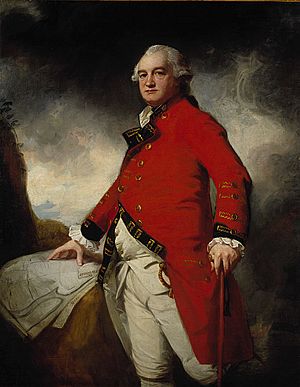James Stuart (British Army officer, died 1793) facts for kids
Quick facts for kids
James Stuart
|
|
|---|---|

Portrait by George Romney, c. 1786
|
|
| Died | 2 February 1793 |
| Allegiance | |
| Service/ |
|
| Rank | Major general |
| Commands held | Madras Army |
| Battles/wars | Seven Years' War Second Anglo-Mysore War |
James Stuart (who died on February 2, 1793) was an important British Army officer. He served in many battles in India during the 1700s. He worked for the British East India Company, which was a powerful trading company that also had its own army.
Stuart had some big disagreements during his time in India. One was with Lord Pigot, who was the governor of Madras. Stuart even arrested Lord Pigot in 1776. This led to Stuart being temporarily removed from his job as commander-in-chief. He was later cleared of any wrongdoing in 1780.
He also fought in the Second Anglo-Mysore War. But he was again removed from his command in 1782 by Lord Macartney. Stuart had a serious disagreement with Lord Macartney, which led to a physical confrontation. James Stuart was the younger brother of Andrew Stuart, a lawyer and politician.
Contents
Early Military Service
James Stuart began his military career in 1755. He became a captain in the 56th Regiment of Foot. His first experience in battle was at the siege of Louisbourg in 1758. This battle took place in what is now Nova Scotia, Canada. He served under Lord Amherst.
In 1761, Stuart helped capture Belle Île, an island off the coast of France. He was promoted to lieutenant-colonel during this mission. After Belle Île, he went to the West Indies. There, he fought in the campaign to capture Martinique in 1762.
His regiment then joined the mission to capture Havana, Cuba. Stuart showed great bravery during the attack on Morro Castle. Capturing this castle was key to winning the battle for Havana.
Conflict with Governor Pigot
In 1775, James Stuart joined the British East India Company. He became the second-in-command on the Coromandel Coast in India. He arrived to find a lot of tension. The local council of the Madras Presidency was arguing with the governor, Lord Pigot.
On August 23, 1776, Stuart arrested Governor Pigot in Madras. He did this because most of the council members told him to. When the news reached England, the directors of the East India Company were not happy. They removed Stuart from his position as commander-in-chief of the Madras Army. He had taken this job after Sir Robert Fletcher died in 1776.
Stuart asked for a trial many times. Even with orders from England, it took a long time. Finally, in December 1780, he had a court-martial. He was found innocent and was given all the pay he had missed since his suspension.
Battles in the Anglo-Mysore War
On January 11, 1781, Stuart was put back in charge of the Madras forces. He returned to Madras and fought under Sir Eyre Coote. He took part in the Battle of Porto Novo on July 1. Stuart was praised for how well he managed the second line of the British army.
In the Battle of Pollilur on August 27, he was badly wounded by a cannonball. He was promoted to major-general on October 19. When Sir Eyre Coote went back to Bengal, Stuart took command of the forces in Madras.
However, Lord Macartney, the new governor, did not give Stuart as much freedom as Coote had. When Hyder Ali, the ruler of Mysore, died on December 7, Lord Macartney wanted Stuart to attack the Mysore army right away. Stuart felt his troops were not ready. He waited two months before making any major moves.
Dismissal and Return Home
While Stuart was leading the siege of Cuddalore, the Madras government removed him from command again. He was held in Madras and then sent back to England.
On June 8, 1786, Stuart had a serious disagreement with Lord Macartney. This led to a physical confrontation in Hyde Park. Stuart was still recovering from his old wounds and needed support to stand.
On February 8, 1792, he was appointed colonel of the 31st Foot. James Stuart passed away on February 2, 1793. His portrait was painted by George Romney. He was married to Lady Margaret Hume, but they did not have any children.

